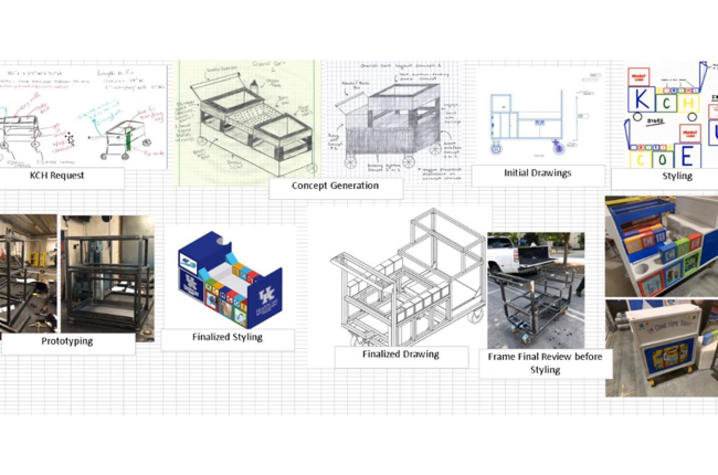UK College of Engineering, Toyota, Collaborate to 'Lift Up' KCH Patients
LEXINGTON, Ky. (March 23, 2021) – When Toyota engineer Jeremy Sharp and his wife Katie left the neonatal intensive care unit (NICU) at Kentucky Children’s Hospital with their newborn son Brayden, they realized they weren’t going to have the celebratory homecoming they had imagined.
“There are a lot of expectations that just got thrown out the window,” said Sharp. “You don’t expect your kid to have a feeding pump, have profound hearing loss or for some families, leaving with other things like an oxygen tank.”
Brayden was born with a rare genetic condition that required highly specialized care. Leaving the hospital after 21 days in the NICU became an exercise in logistics and creativity.
Luckily for the Sharps and other NICU families, Toyota Motor Manufacturing of Kentucky (TMMK) and the UK College of Engineering were already working on a solution.
After successfully partnering on creating a unique experience for former KCH patients at UK football games, engineers from Toyota and students from the UK College of Engineering brainstormed on what their next collaboration could be as part of their “Lift Them Up” mobility campaign. They heard stories of other families, like the Sharps, who faced the complicated task of transporting a medically fragile newborn from the NICU to their car.
“We determined that there was a need for a mobility vehicle that can take a patient when they’re ready to go home; there was a need for some sort of cart that could carry them safely as well as the parents’ belongings and any equipment they needed,” said Nick Potocki, engineering manager at Toyota. “So we decided that this was the project we needed to do.”
The engineers took their idea to Nelson Akafuah, Ph.D., lecturer and associate director for the Institute of Research for Technology Development in the UK College of Engineering. Akafuah and his students worked with Toyota previously on the Lift Them Up cart, and he was excited for the opportunity to continue to address the challenges faced by KCH patients.
The challenge was to create a car that could not only safely transport a medically fragile newborn, but to also have space for any supporting equipment such as oxygen tanks. In the fall of 2019, Akafuah tapped mechanical engineering students Andrew Roach, Brielle Hamilton, William Brennan, Ashley Mattingly, Caralyn Collins, and Andrew Schaefer to design the cart for the senior design capstone project. The senior design capstone is a two-semester sequence of coursework comprising three key steps: planning and information gathering, concept generation, evaluation and selection, and design embodiment.
The initial student team could not complete the construction of the cart due to the impact of the COVID-19 pandemic in the spring of 2020. After the initial team graduated in May 2020, Akafuah tapped mechanical engineering senior Binit Singh to be the student liaison between the NICU and Toyota to complete the project.
“These types of projects give engineering students unique opportunity to address societal issues through engineering,” said Akafuah. “Working with experienced engineers from Toyota help expand their engineering education.”
“We worked together to come up with multiple ideas and then narrowed down the concept based the needs of hospitals based and what parents would like to see in the car,” said Singh. “We built a prototype and demonstrated a proof of concept. Then we started making a real fabrication to build the cart. It’s teamwork with everyone being involved and coming up with ideas from beginning to end.”
The cart has a number of features, including a seatbelt to secure the car seat and compartments for an oxygen tank and other support equipment. The base of the cart includes storage for the family’s belongings and a pull-out drawer big enough to hold a cooler for transporting breast milk. The exterior is decorated with images of the tile mosaics found throughout the NICU and a white board announcing the baby’s journey home.
The Sharps brought along baby Brayden to check out the cart when it was delivered to KCH.
“When you put your child in there and there’s a spot for their feeding pump, a spot for a cooler and for some patients, a spot for other things like an oxygen tank, you’re saying, 'Wow, somebody thought of my situation,'” said Sharp. “And that gives you a lot more comfort, going out, knowing that somebody thought of you and your situation, even though it feels so crazy and foreign to you at the time.”
Toyota fabricated two identical carts for KCH. Singh and the Toyota engineers gave the NICU staff a tour of the carts’ features and will be available to provide maintenance and repairs as needed.
While Toyota and the UK College of Engineering look ahead to the next collaboration, the staff at KCH are glad to provide families and patients a small comfort during a difficult period.
“To give our NICU staff a tool like this, and to be able to further provide care, we couldn’t do this without the College of Engineering and our partners at Toyota,” said Dr. Scottie B. Day, physician-in-chief at KCH. “We’re very appreciative.”
As the state’s flagship, land-grant institution, the University of Kentucky exists to advance the Commonwealth. We do that by preparing the next generation of leaders — placing students at the heart of everything we do — and transforming the lives of Kentuckians through education, research and creative work, service and health care. We pride ourselves on being a catalyst for breakthroughs and a force for healing, a place where ingenuity unfolds. It's all made possible by our people — visionaries, disruptors and pioneers — who make up 200 academic programs, a $476.5 million research and development enterprise and a world-class medical center, all on one campus.








